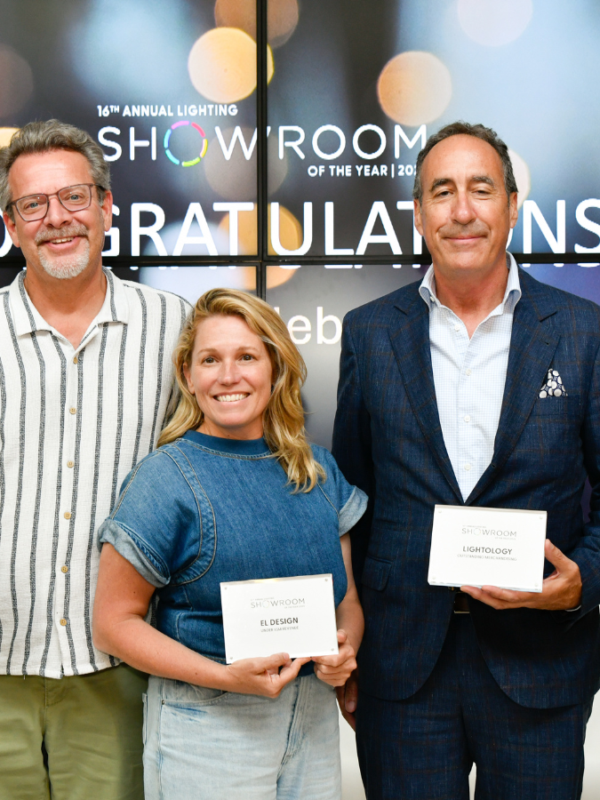By Kathleen Jennison, KTJ Design Co.
Let’s be honest: lighting has graduated from background player to full-blown star of the show in any well-designed space. We’re no longer just swapping bulbs — we’re sculpting moods, framing architecture, and flat-out bossing the vibe.
As an interior designer who’s spent years convincing clients that overhead lighting is not a personality, I’m here to spill four secrets we all know about lighting —but don’t say out loud often enough. This one’s for the showroom pros and fellow designers who want to not just sell fixtures, but sell the feeling lighting creates.
Secret #1: The Layout Doesn’t Work if the Lighting Doesn’t Work
We all preach layout like it’s gospel (and it is), but even the most meticulously zoned floor plan can fall flat if the lighting doesn’t reinforce it.
Lighting is the invisible line that guides clients through the space. Task lighting defines function. Ambient lighting creates comfort zones. Accent lighting gives rooms direction — literally and emotionally.
Here’s the designer trick: When we plan layouts, we also visualize lighting zones as spatial boundaries. That chandelier? It doesn’t just float over the dining table — it anchors the area. A pair of sconces in the hallway don’t just provide visibility; they say, “This is a passage, not a parking lot.”
Pro tip for lighting showrooms: Sell your fixtures as layout partners, not just stand-alone pieces. Ask your designer clients about traffic flow, focal points, and furniture placement. You’re not just providing a fixture, you’re solving a problem they didn’t know they had.
Secret #2: Layered Lighting Is Not Optional — It’s the New Baseline
Let’s call it out: if a designer presents a lighting plan with a single ceiling fixture per room, it should come with a formal apology. The layered lighting trifecta – ambient, task, and accent – isn’t revolutionary anymore. It’s essential.
Here’s the next evolution: psychographic lighting. That’s right, we’re designing lighting based on how our clients want to feel, not just what they want to do.
• Want a kitchen that transitions from morning smoothie to dinner party? Layered lighting.
• Want a powder room that makes guests feel like they’re in a boutique hotel? Layered lighting.
• Want to age gracefully without fluorescent regret? Yep, layered lighting.
What lighting showrooms can do: Curate fixture vignettes by mood, not just style. “Relaxed + Restorative” versus “Moody + Masculine” says a lot more than “Transitional Lighting.” Position yourself as a co-creator of ambiance, not just a hardware provider.
Secret #3: Mixing Materials Isn’t Just for Furniture — It’s a Lighting Strategy
In interior design, we talk endlessly about material mixology: velvets with woods, brass with boucle, and so on. But lighting? It’s often still stuck in the monochrome matchy-matchy zone.
Lighting is one of the best ways to bring material depth and finish contrast into a room.
My go-to combos are:
• A matte black chandelier in a room full of creamy neutrals? Instant edge.
• Mixed-metal sconces against patterned wallpaper? Elevated drama.
• Hand-blown glass pendants over a butcher-block island? The perfect balance of polish and texture.
For lighting professionals: Start conversations about finish interplay. Suggest pairings that introduce subtle tension — because good design lives in that sweet spot between contrast and cohesion. Don’t be afraid to steer clients away from “matching sets.” Curated feels rich. Coordinated feels retail.
Secret #4: The Most Personal Spaces Are Lit Personally
Here’s where lighting crosses from functional to emotional. I always say the most memorable rooms are the ones where lighting feels tailored, not templated.
Think about the bedroom where reading lights are dimmable and adjustable for each side of the bed. Or the entryway where a glowing pendant welcomes you home like it knows your name. Or the kitchen island where pendant lights dim just enough for wine night, but still make the countertops sparkle.
Lighting isn’t just about visibility — it’s about storytelling.
Designers: Push clients to think beyond, “Will this light work here?” to “How will this light make me feel when I walk in?” The answer will almost always be the one they remember you for.
Showrooms: Don’t just ask for the room size. Ask what the room means to the client. A powder room that needs to impress guests? You’re selling confidence. A home office that doubles as a Zoom backdrop? You’re selling lighting that flatters. Position your products in emotional context — it’s the kind of selling that sticks.
The Bottom Line: Lighting is the Silent Stylist. It has quietly become the defining layer of luxury and livability. It’s not just about brightness or style, it’s about presence. And as designers and lighting professionals, we’re not just picking fixtures — we’re crafting experiences.
So whether you’re designing, selling, or specifying, remember that layouts mean nothing without lighting flow.
• Layering is the baseline, not the bonus
• Materials should mix, not match
• Lighting should reflect personality, not just purpose
We all know these secrets. It’s time to speak them louder — and light the way.
______________________________________________________________
Kathleen Jennison is the owner and principal designer at KTJ Design Co., a California-based interior design firm known for transforming life transitions into livable luxury. She’s also a lighting enthusiast with a passion for warm dimmers, layered mood, and never matching her metals.
Related articles
What Interior Designers Wish Lighting Showrooms Knew: A Designer’s Perspective on Successful Collaborations




